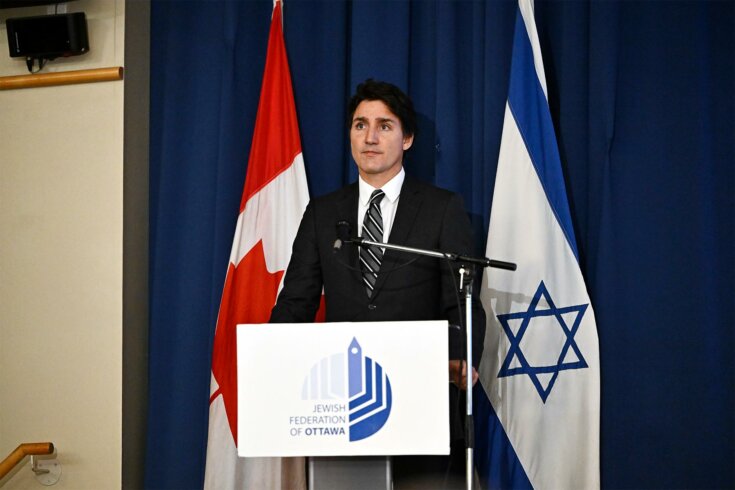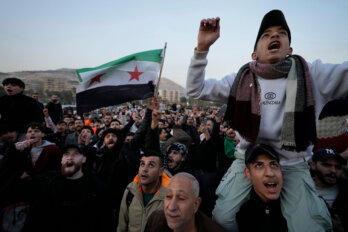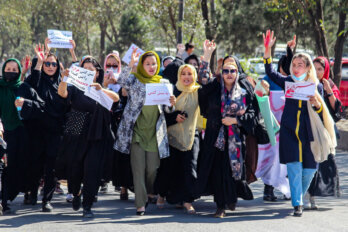Residents of the Gaza envelope, as they call the roughly fifty communities encompassing 70,000 people living in towns and villages on the Israeli side of the Gaza–Israel border, are used to middle-of-the-night sirens alerting them to Hamas-launched Qassam rockets. They have a well-established routine. If there’s time, they go to their secure room. If not, they await impact, hoping the rockets won’t hit their homes.
On the morning of October 7, close friends of mine were holed up in their secure room. While they normally wait for the rockets to land before resuming their routines, this time they heard a terrifyingly unfamiliar sound: militants, who they rightly assumed were Hamas, roaming outside their front door. While the Israeli military and police would take many hours to arrive, their own kibbutz volunteer readiness force engaged the militants in a firefight. Soon, the two Hamas operatives lay dead on the sidewalk in front of their house, in the exact spot where I have stood many times. My friends narrowly escaped being murdered, burned alive, or taken hostage. Another friend of mine, Canadian-Israeli peace activist Vivian Silver, who lives in nearby Kibbutz Be’eri, wasn’t so lucky. Abducted by Hamas operatives, Vivian now sits in captivity in Gaza along with over 240 other hostages, a number that includes at least thirty children. As of this writing, Hamas has released four hostages; another one, a soldier, was rescued.
Watching the news unfold, of over 1,400 Israelis, mostly civilians, being gunned down that day, Jews worldwide experienced intergenerational Holocaust trauma, the unconscious terror always lurking in our DNA. Our worst nightmare is intruders coming into our house and seeking to kill or kidnap us as we place our bodies between murderers and our own children. October 7 was the bloodiest day for Jews since the Nazis concluded their extermination campaign.
And now, predictably, Israel has responded with massive use of force in Gaza, promising to root out Hamas. It has cut off the supply of food, water, fuel, and electricity to the region, with nearly two weeks passing before convoys of humanitarian trucks were finally able to enter through the Rafah crossing. From the outset, we saw statements from Israel’s prime minister, Benjamin Netanyahu, calling for revenge. Given what Israelis endured that day, collective rage is understandable. But vengeance is a terrible guide for military action.
The scale of Israeli bombing shows a disregard for key principles of international humanitarian law. Many Palestinians in Gaza do not support Hamas. And even if they did, all care must be taken to protect civilians. This is called the principle of distinction—distinguishing non-combatants from combatants. Second, the force used must not exceed what is needed to achieve the given military objective. Collective punishment must be avoided at all costs. As of this writing, over 10,000 Palestinians, mostly civilians, have been killed—a figure that includes a staggering 4,000 children—with the rest of Gaza’s 2.1 million people facing a humanitarian disaster of epic proportions.
Where does this leave Canada? We must continue to operate on two levels: one globally and the other locally. We must demand an immediate ceasefire and the provision of humanitarian relief while we continue to call for the release of hostages by Hamas. Canada has pledged $50 million in humanitarian assistance to Palestinians in Gaza, on top of the $10 million Prime Minister Justin Trudeau earmarked initially. In international meetings in the region, foreign affairs minister Mélanie Joly has expressed concern about the humanitarian crisis in Gaza since Israel demanded that over 1 million Palestinians flee from the northern to the southern half of the Gaza Strip. With a population density nearly twice that of Toronto, such forced displacement is a cruel and unreasonable demand. And while more than hundreds of thousands of Palestinians did obey Israel’s call, Israeli military keeps targeting the very areas civilians are told to go to.
Why don’t Palestinians just try to leave Gaza altogether? Palestinians have no airport. Their sea access is curtailed by Israel. There are two ground exits: one into Israel, the other into Egypt. Egypt is, and always has been, highly restrictive about who it admits from Gaza. The northern part of Egypt, the Sinai Desert, has insufficient infrastructure to support a Palestinian refugee population. And fearing they wouldn’t be allowed back, Palestinians are wary of leaving en masse. They fear a second round of ethnic cleansing: in 1948, pre-state forces drove 750,000 Palestinians from their homes. When the Arab-Israeli war ended in 1949, Palestinians, now refugees, were never granted return, nor were they compensated for their properties. Anything they left behind—land, houses, personal effects—was appropriated or destroyed by the new state of Israel. Already, an internal document from the Israeli intelligence ministry reveals that a full ethnic cleansing plan, which would entail transferring the Palestinian population from Gaza into Egypt, has been floated in detail.
How should we talk with one another about these issues amidst such anger, moral outrage, and fear? We must ensure that our conversations, our rallies, our vigils, and our public statements are values based. Members of these communities are rightly scared of hatred intensifying in our midst. Already, the horrific news from south of the border, that a six-year-old Muslim boy was murdered in Illinois in an apparent hate crime by a white (and non-Jewish, non-Muslim) American, is chilling. In cities and campuses across Canada, Jewish-Palestinian tensions are at an all-time high.
We must stand for dignity, freedom, and the protection of civilians from harm. Statements like those out of some unions praising the Hamas massacre of October 7 have no place here. Accordingly, we must stand with Israeli civilians who were just trying to go about their lives. We must stand with Palestinian civilians in the West Bank, scores of whom have been shot dead by Israelis since last month’s war began, and all of whom have suffered for decades under Israel’s brutal military occupation and savage attacks by Israeli settlers. And it is urgent that we stand with Palestinian civilians in Gaza, who are facing a humanitarian disaster and whose daily conditions, even before October 7, have been nearly unlivable, some of it the fault of their own authoritarian leaders and much of it the responsibility of Israel’s decades-long blockade.
And when this immediate crisis ebbs, we must urge our government to take the kind of leadership role it once had, many years ago, when it shepherded the multilateral working group on Palestinian refugees. Other such groups focused on water, the environment, economic development, and security. These working groups emerged out of the 1991 Israeli-Arab peace talks at Madrid—hosted by the US and Russia just as the Cold War had ended—where Palestinians were forced to participate only in the context of a joint Jordanian-Palestinian delegation. While well intentioned, and despite Canada’s reputation as a Middle East peacekeeper starting in the 1950s, giving hope that it could help parties find common ground, the talks faltered. Among other things, Palestinians were concerned with return, restitution, and compensation for properties lost. Israel preferred to keep the discussion focused on resettling the refugees in their new host countries around the region. The rest of the working groups dissolved by the mid-1990s as well.
Sadly, today there are no peace talks of any kind to support. The last round collapsed in 2014. Since then, Palestinians have felt betrayed by Israel’s continued West Bank settlement building, tacit support for settler violence, and de facto moves to annex parts of the territory. Israelis have felt hemmed in by episodes of violent Palestinian resistance—and even by the kind of non-violent protest embodied in the global BDS movement, which calls for boycott, divestments, and sanctions against Israel. Israeli officials repeatedly state that, in the Palestinians, they have “no partner.”
It feels almost bizarrely nostalgic to invoke the multilateral talks, when Canada played a leadership role, now. But Canada’s values have not changed since then. And we must lead where we can. Canada is understandably concerned with getting its own citizens out of harm’s way, including at least 14,000 Canadians in Lebanon, where another front threatens to open between Israel and Hezbollah. Canada has arranged flights for its citizens there, though media reports suggest that there are logistical challenges even with a working airport. Getting Canadian citizens out of Gaza has proven more difficult. The only possible exit, the one between Gaza and Egypt, remains largely sealed.
Farther north, Israel has evacuated twenty-eight communities, bringing the total number of displaced Israelis to 200,000. Across Israel’s northern border with Lebanon, Hezbollah and the Israel Defence Forces have been trading fire. Neither side has an incentive to see a repeat of the 2006 Israel–Hezbollah War in Lebanon, but observers are on high alert.
Beyond that, Canada must adhere to its stated policy of supporting Palestinian self-determination through a territorially contiguous state. This also means criticizing Israel’s collective punishment of Palestinians in Gaza as well as its human rights violations in the West Bank as the occupation grinds on. And while the two-state solution as the goal has been the international consensus for decades within the international community, Canadian diplomats may wish to explore related, but perhaps more creative, options like confederal approaches. These, as embodied in groups like A Land for All, would entail two states but with an important difference from the conventional two-state solution. Citizenship and residency would be decoupled. And there would be freedom of residency and movement for all. Thus, West Bank settlements, long seen as an insurmountable impediment to a two-state solution, could stay in what would become a Palestinian state; the Israeli citizens living there would, of course, have to obey local laws, just as would the Palestinian refugees who would finally be allowed to return to live in their towns inside Israel, if they wished.
The task of finding a solution has never been more challenging, but neither has it been more urgent. The one friend I have in Gaza, an Arabic teacher I’ve been meeting with weekly, sometimes more often, for over a year, is named Sara. When she is able to charge her phone with the limited electricity there, we’ve been able to communicate on WhatsApp. She is pregnant. She is understandably afraid to eat spoiled food that could be rotten. And she has seen death all around her. She tells me she does not know whether she will survive.




